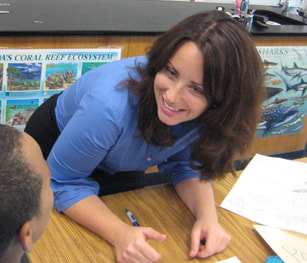I believe that effective educators must possess deep knowledge of their subject, varied pedagogical tools, and an absolute respect for students of all backgrounds and abilities. I always keep learning new science content and teaching strategies in order to best serve my students. This ability to transition between the roles of student and teacher, often and with great enthusiasm, has facilitated my success as an educator for the past eighteen years.
Why do I teach?
Though I have a passion for my subject matter, I am first and foremost a teacher of students, not of science. Building positive relationships with my students and helping them grow as learners is the reason I chose a career in science education and it is what keeps me motivated. I love teaching at the middle school level because it is a critical age for adolescent development and I appreciate the team structure with teaching colleagues.
Teaching science is truly my vocation because it is the intersection of my talents and the needs of the community. The science behind news stories, environmental issues, political debates, and personal health choices requires today’s citizens to be scientifically literate more than ever before. Natural and human systems are increasingly interconnected on local and global levels. Therefore, it is critical I facilitate a robust science education for all my students.
Teaching science is truly my vocation because it is the intersection of my talents and the needs of the community. The science behind news stories, environmental issues, political debates, and personal health choices requires today’s citizens to be scientifically literate more than ever before. Natural and human systems are increasingly interconnected on local and global levels. Therefore, it is critical I facilitate a robust science education for all my students.
What do I teach?
|
By guiding students through an inquiry process, I help them gain a solid foundation in science, technology, engineering, and math (STEM) principles. My courses emphasize both logic and imagination through integrated projects, so I consider myself a STEAM educator with the A added for arts. My students are also provided opportunities to express their learning through a variety of media like videos, podcasts, blogs, etc. I hope I am nurturing future scientists, but I also believe that no matter what path students choose in life, they must develop creativity, collaboration, and communication skills.
|
More than anything else, learning comes from experience. In my courses, science is a verb: hands-on activities and investigations require students to put their knowledge into action. Students are also provided authentic educational experiences outside the classroom, such as biological field studies and environmental service projects. Nature is my favorite classroom. I believe that that place-based, experiential learning rooted in local ecology engages student senses, enriches science content, and encourages a conservation ethic.
How do I teach?
My students say I make learning fun, for I approach even the most sophisticated content with playfulness. I put a lot of effort into designing effective lessons, but then I let classroom interaction organically unfold— always willing to spontaneously clarify misconceptions or invite student discussion. I react to student concerns with flexibility and empathy to build trust.
In my classroom, students are encouraged to ask salient questions, provide evidence to support their claims, and take responsible risks. To foster this intellectual growth, I have high standards yet accept mistakes as part of the learning process. In order to measure student growth, I collect a variety of data through formative and summative assessments. Yet, most importantly, I encourage an open feedback loop with students, so I can continually refine my practice to meet student needs.
In my classroom, students are encouraged to ask salient questions, provide evidence to support their claims, and take responsible risks. To foster this intellectual growth, I have high standards yet accept mistakes as part of the learning process. In order to measure student growth, I collect a variety of data through formative and summative assessments. Yet, most importantly, I encourage an open feedback loop with students, so I can continually refine my practice to meet student needs.
|
Cristina Veresan
Science Educator |
Proudly powered by Weebly
|
